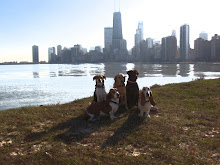Being able to grab your dog’s collar is one of the most important handling skills your dog should possess. When it comes to emergency situations the first thing that people go for is the collar. If your dog is not used to being grabbed this could turn into a very charged situation, even ending in a bite.
It is best to start this skill young and don’t just focus on the collar. Make sure that you can put pressure on the ears, paws, tail and body. All over body handling is key to child proofing a dog. Begin softly and do not hang on for any long period of time. Hang on just long enough to deliver the reward and let go. Duration comes later.
Let’s set this up, shall we. Stock up on small bits of kibble or treats. Touch or gently grab the dog’s collar. Say “gotcha!” and food reward. Let go. If you have a dog that does not like being touched or immediately jumps back when you go to grab you’ll have to go much slower. Try one of two things. Present the treat first in a closed fist. As the dog is focused on the treat slowly reach in to touch the collar. Open your hand the same time you touch the collar, letting the dog eat the treat. The second way is to put a lead on the dog. Grab the lead at the end, saying “gotcha!” and rewarding. As the dog becomes comfortable, slowing work your way up the lead. This is a big trust game. That means no collar punishment - including but not limited to collar shakes, collar pops, or general rough collar treatment. This is especially true if you have a dog that is at all skittish or shy of handling.
If you have a bouncy, outgoing dog that doesn’t mind the light stuff then begin to get sloppier in the grab or quicker in the grab. By sloppy I mean lightly grabbing some of the scruff with the collar or the fur around the collar if it’s a coated dog. Do not make the dog squeak in pain. Make sure to do this throughout the day and at random times. Don’t forget to reward!!!
When it comes to the body parts start slow and soft, almost like a massage. If at any time the dog lets you know that you’re going to fast or handling too hard back up a step. When applying pressure, do it within reason. Do not yank on the ears or tail. Place only enough pressure to restrain, not hurt. It’s good for dogs to get used to rough handling, but be sure to not cross the line.
Monday, December 28, 2009
Friday, December 25, 2009
A lesson learned
I learned a valuable lesson tonight about judging someone by the equipment they use with their dog. My cousin made a comment about the remote collar on Bailey and I was floored. I would never use a piece of equipment on my dog that would cause serious harm, pain, or otherwise damage our relationship. So before you think about judging someone based on their training collar choice, think twice. You don't know how or why they are using it.
*** If you have further questions about my use of the remote collar in my training, please feel free to ask. ***
*** If you have further questions about my use of the remote collar in my training, please feel free to ask. ***
Subscribe to:
Posts (Atom)



